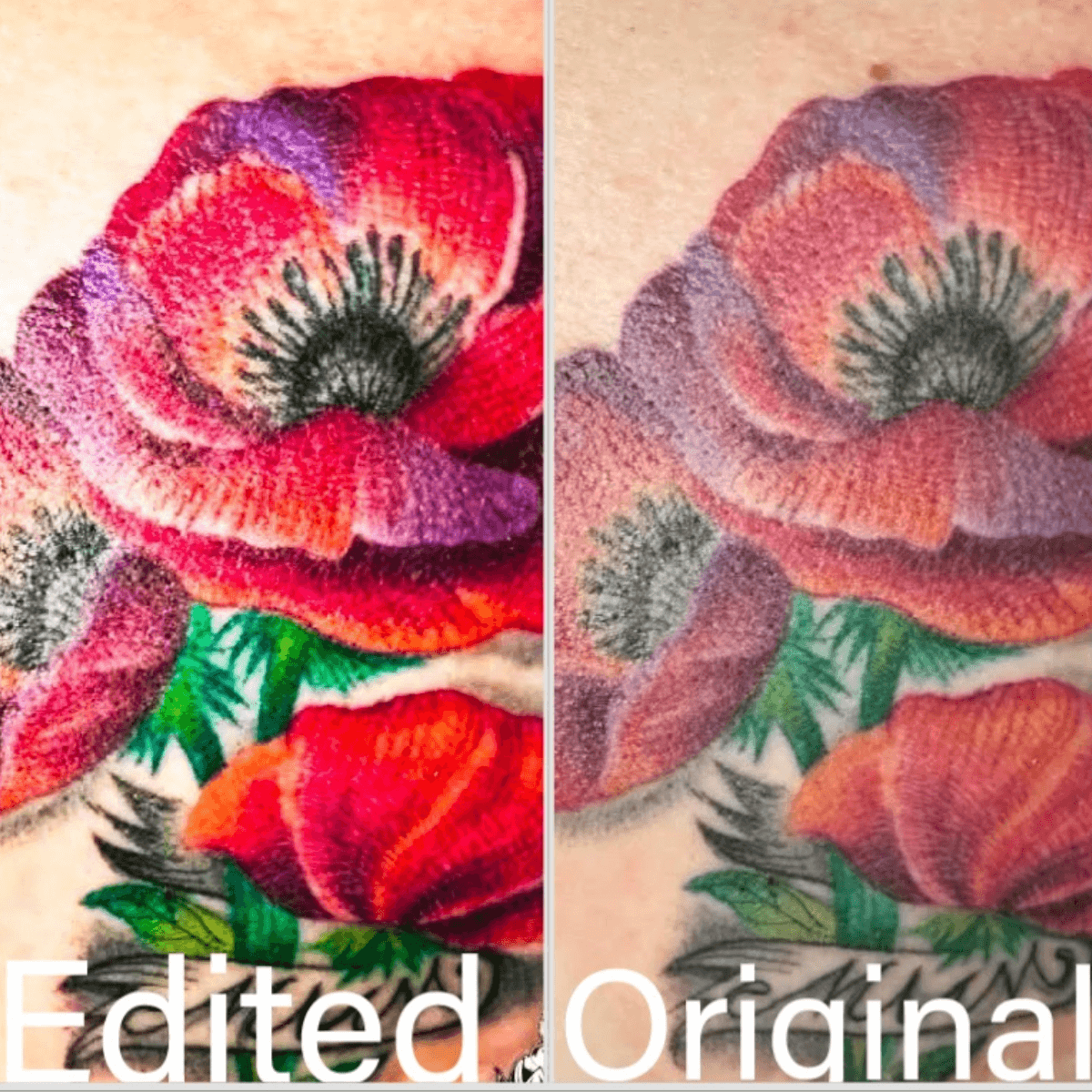Let’s be real—social media has completely changed how tattoos are showcased. Scroll through Instagram, and you’ll see countless tattoo photos that practically glow with vivid colors, razor-sharp lines, and skin that looks airbrushed to perfection. But here’s the truth: many of those images have been edited so much that they no longer reflect reality.
At The Bamboo Rooms, we keep things real. Our photos show tattoos as they are—redness, swelling, and all. Why? Because you deserve to know exactly what you’re getting. We’re not here to sell you a fantasy; we’re here to create beautiful, honest art. But not every studio has the same approach. So how can you tell when a photo has been manipulated? And why does it matter so much?
Why Do Studios Edit Tattoo Photos?
It’s easy to see why photo editing has become the norm:
- The Social Media Show: Everyone wants their tattoos to pop in a busy feed. To stand out, some studios crank up the saturation, smooth out the skin, and make everything look polished and perfect.
- Hiding Natural Imperfections: Fresh tattoos come with redness, swelling, and sometimes even a bit of bruising. That’s just how skin reacts. But instead of embracing this reality, some studios edit out every natural sign of the process.
- Staying Competitive: In an industry where your online portfolio is everything, there’s pressure to make tattoos look flawless. But when you edit beyond recognition, it stops being about the tattoo and starts being about digital trickery.
A Quick Example: The Poppy Tattoo
Take our poppy tattoo as an example. A quick three-second edit in Photoshop was all it took to make the colors appear much bolder and more intense. That simple overlay turned a realistic, natural-looking tattoo into something impossibly bright. Heck, we even removed the client’s freckle at the top of the flower. However, the truth is, no ink in the world can achieve that level of saturation on real skin.
This example shows how easily tattoo photos can be manipulated to create a false impression. With just a few clicks, an everyday tattoo can be made to look like it’s glowing with vibrancy. So when you see these kinds of images online, it’s important to remember that digital tools can turn reality into something no artist can replicate in real life.
The Reality of Tattoo Colors
One of the most common editing tricks is boosting color saturation. You know those ultra-bright neon blues or reds that look like they’re lit from within? Those colors often aren’t achievable with tattoo ink alone.
Tattoo pigment interacts with your skin tone, and that can naturally affect how colors appear. Even the brightest pigments will soften as they heal and settle into the skin. Editing apps make colors look richer and more intense, giving people unrealistic expectations about how their tattoo will look long-term.
Your Skin: A Living Canvas
This is something we’re passionate about. Your skin is a living, breathing organ that stretches, moves, and changes. It’s not a flat, static sheet of paper.
Every time you flex, twist, or even relax, your tattoo moves with you. This is especially important to understand if you’re getting a tattoo with fine lines or intricate details. On real skin, straight lines may appear to bend or shift as you move—and that’s normal.
And as the ink settles, it can spread slightly, softening very fine details over time. This doesn’t mean your tattoo won’t look great—it just means it will become a natural part of your skin as it heals and ages.
How to Spot an Edited Tattoo Photo
If you want to avoid falling for overly edited tattoo photos, here’s what to look for:
- Unrealistic Colors: If the colors seem brighter or “glow” unnaturally, it’s a sign the saturation has been pushed beyond what’s possible. Tattoo ink doesn’t work like neon paint—it doesn’t shine like a lightbulb.
- Perfect Skin with No Redness: Getting a tattoo isn’t exactly a day at the spa—your skin will react with redness, swelling, and sometimes irritation. If the skin looks flawless and smooth with no redness or texture, it’s probably been airbrushed.
- Glow Effects: Some photos make the tattoo look like it has a soft halo of light around it. This is not the result of an artist’s skill—it’s Photoshop magic. No tattoo ink can glow!
- Even Skin Tone: Skin has natural shadows, highlights, and textures. If the skin tone looks perfectly even across the entire photo, that’s a clear sign it’s been digitally altered.
- Blurred Lines or Background: Sometimes studios will blur the edges of a tattoo or the background to make the tattoo appear sharper in comparison. But sharp tattoos don’t need that trick. If you see a hazy background or fuzzy edges, that’s likely an editing trick to hide imperfections.
Why We Don’t Edit Photos at The Bamboo Rooms
At The Bamboo Rooms, our philosophy is simple: honesty above everything. When you look at our portfolio, you’re seeing the real thing. We don’t use filters or enhancements to change the way our tattoos look. The photos we post capture our tattoos exactly as they are—sometimes with redness or swelling, because that’s the truth.
We want you to walk into your session with realistic expectations and confidence in what you’re getting. Tattoos aren’t about achieving digital perfection—they’re about creating something meaningful that lives and breathes with you.
Why Authenticity Matters
Getting a tattoo is a permanent decision. You deserve to know what you’re signing up for, and that starts with seeing real, unedited work.
At The Bamboo Rooms, we don’t chase likes and shares with impossible photos. We focus on creating timeless, meaningful tattoos that are as beautiful in person as they are in our photos. Our tattoos move, stretch, and change with you. And while some fine details may soften over time, we believe that’s part of the beauty of having a tattoo—it becomes a living, breathing part of who you are.
So next time you’re scrolling through tattoo portfolios, take a closer look. Don’t be dazzled by glowing colors and flawless skin. Look for the truth beneath the filters. And if you want real, honest work? You’ll always find it at The Bamboo Rooms.
No tricks. No edits. Just timeless art, made to move with you.





